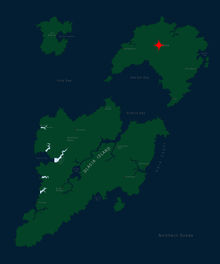Alpine, Ceneria
| The City of Alpine, Ceneria Alpine
|
|||||
|---|---|---|---|---|---|
|
|||||
| 'Motto: "In The Mountains We Find Our Strength. | |||||
The City of Alpine's location in Ceneria.
|
|||||
| Official languages | Taréquin | ||||
| Demonym | Alpinean | ||||
| Government | Representative Democracy | ||||
| - | President | Samuel Leneran McLaughlin | |||
| Legislature | Alpine Council | ||||
| - | Upper house | The Cenerian National Council | |||
| - | Lower house | The Alpine Regional Council | |||
| History | |||||
| - | Date of Establishment | August 16th, 1581 | |||
| - | Made regional capital | 1607 | |||
| - | Made national capital | 1651 | |||
| Area | |||||
| - | Total | 218 km2 84.2 sq mi |
|||
| - | Water (%) | 2.5% | |||
| Population | |||||
| - | 1947 estimate | 844,910 | |||
| - | Density | 0/km2 0/sq mi |
|||
| Time zone | Cenerian Standard Time (UTC+5) | ||||
| Drives on the | left | ||||
| Calling code | 330+12 | ||||
Alpine is the capital city of Ceneria. It was officially founded on August 16th, 1581, by the colonists of the nation Wariem. A celebration called "Founding Day" is held every year on this date. It was made the regional capital for the Cenerian Islands in 1607. After the Cenerian revolution ended in 1648, the new nation of Ceneria made the thriving city its capital in 1651. Today, Alpine is the home of a bustling tourist economy, as the city is famous for its stunning buildings and its proximity to the majestic Alpine Range.
History
Early History
The Alpine Valley was discovered in 1573 by the Wariem Royal Exploration Society during their effort to map all of Alpine Island. They hoped to accomplish this by using a hot-air balloon to soar over the mountains. This effort failed when the balloon was swept out over the ocean by squall, sank, and ended up killing two of its pilot, who did not manage to escape the sinking wreckage before help arrived. The exploration team was forced to follow a valley system towards the center of Alpine Island, which brought them to the location of what would be alpine. The forested valley here stunned the explorers, and they spent several days mapping the area. They left towards the north in search of other possible assets to their exploration after this. There is no record of the Alpine Valley being visited again until 1580.
Founding
In the late fall of 1579, colonist Harry Fairbanks, a native of Wariem, began a private quest to search out the site for a settlement. He uncovered the maps made by the Wariem Royal Exploration Society in 1573 and immediately noticed the placing of the Alpine Valley. He, with the help of several friends and family members, began to load vehicles for the journey inland so that they could set out as soon as the spring thaw began. They left the coastal settlement of Spurr in early May, and proceeded to travel inland towards the valley for six days until a late snowstorm struck the mountains. This late storm killed two of the colonists, A cousin and Farbanks' young son, Louis. This tragedy nearly persuaded him to return to Spurr, but he resolved to push on in the memory of his son, who had been the driving force behind the choosing of the site. The colonists reaced the Alpine Valley in late June and constructed temporary houses to spend the rest of the thaw in. They finished their permanent settlement in late September, just in time for a second wave of colonists. These colonists quickly constructed makeshift shacks for shelter, as the winter storm season had already begun. The following spring, the third and largest wave of colonists arrived, and Fairbanks dubbed the establishment "Alpine." The name stuck.



